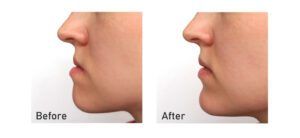Orthognathic Surgery
Orthognathic surgery, more often referred to as corrective jaw surgery, works to reposition the top and bottom jawline when they don’t meet correctly or when the teeth don’t adequately fit within the jaw. Corrective jaw surgery helps correct misaligned jaws and helps improve facial appearance and tooth function for those with severe oral health problems. Through this procedure, the jaws can meet the teeth correctly and help improve speech, sleep apnea, breathing problems, and overall facial aesthetics.
Because of its complexity, orthognathic surgery must be carefully planned through a team approach. Our team of oral surgeons, alongside your general dentist, orthodontists, and other dental specialists, are here to help correct any malocclusions present, improve your jaw function, and give you a more harmonious bite.

Who Can Benefit From Corrective Jaw Surgery?
Jaw growth is a gradual process, and improper growth or injuries to the jawline can cause inconsistencies with bite, mouth alignment and can lead to oral problems such as overbites, underbites, and misaligned teeth. In some cases, orthodontic care can correct toothy alignments, but when mismatched jaws are present, compensating for that can lead to other health problems, including orthodontic relapse, jaw joint problems, and periodontal problems.
Corrective jaw surgery can be used to remedy severe orthodontic problems that cannot be corrected by an orthodontist. Our team first works to understand your oral pathology to determine the relationship between the teeth and jaws and how those aspects relate to your oral health. Under our oral and maxillofacial surgeons, people who have problems with tooth alignment, facial and jaw asymmetry, and other difficulties can use this procedure to correct aesthetic issues and bring balance back to their facial features.
When you visit our office, determining your candidacy for orthognathic surgery will be evaluated from the following areas, including:
- Protruding Jawline or Receding Chin
- Cleft Palate and Other Congenital Defects
- Malocclusions such as Overbites, Underbites, and Crossbites
- Obstructive Sleep Apnea
- Difficulty chewing, swallowing and biting food
- Chronic Jaw Pain
- TMJ Pain
- Imbalanced Facial Features
- Chronic Mouth Breathing
- Facial Trauma From Accidents or Injury
Why University of Oral Surgery Center For Orthognathic Surgery
Our goals as oral surgeons are to help you understand the surgical process and give you a fuller look into the extent of our treatments. To provide proper treatment, our team performs an examination of your oral health and facial features and provides a diagnosis based on the facial or oral issues you may be experiencing. From there, we use computer-aided techniques and 3D modeling equipment to show our personalized treatment plans to correct your facial features, realign your jawline, and provide you with better oral health.
Under the guidance of Dr. Shabtaie, our team works closely with our patients to provide them with assurance, confidentiality, and positive results during treatment. Our practice provides orthognathic surgery as a way to help patients have a healthier dental-facial relationship and an optimal bite. For more information about our services, contact the University of Oral Surgery Center today to schedule your first consultation with us!
